Exploring Voluntary Administration in Australian Corporate Insolvency
VerifiedAdded on 2020/04/07
|8
|2786
|39
AI Summary
The assignment provides a comprehensive examination of Australia's approach to corporate insolvency, focusing on the prevalent use of voluntary administration procedures. Unlike many countries that prioritize creditor-led processes, Australia employs a debtor-in-possession system similar to Chapter 11 in the US. Voluntary administration is highlighted as an especially cost-effective and beneficial method for companies facing financial difficulties. It offers directors a chance to fulfill their fiduciary duties by potentially restructuring or reorganizing their businesses, thereby providing a way to repay creditors. This procedure's advantages include reduced costs compared to alternatives like receivership and liquidation, making it a preferred option in the Australian context. Additionally, the paper discusses various facets of insolvency law, including personal bankruptcy and cross-border cases, while referencing key legislation such as the Corporations Act 2001. The analysis is supported by scholarly references that provide insight into both historical developments and contemporary practices within Australian insolvency law.
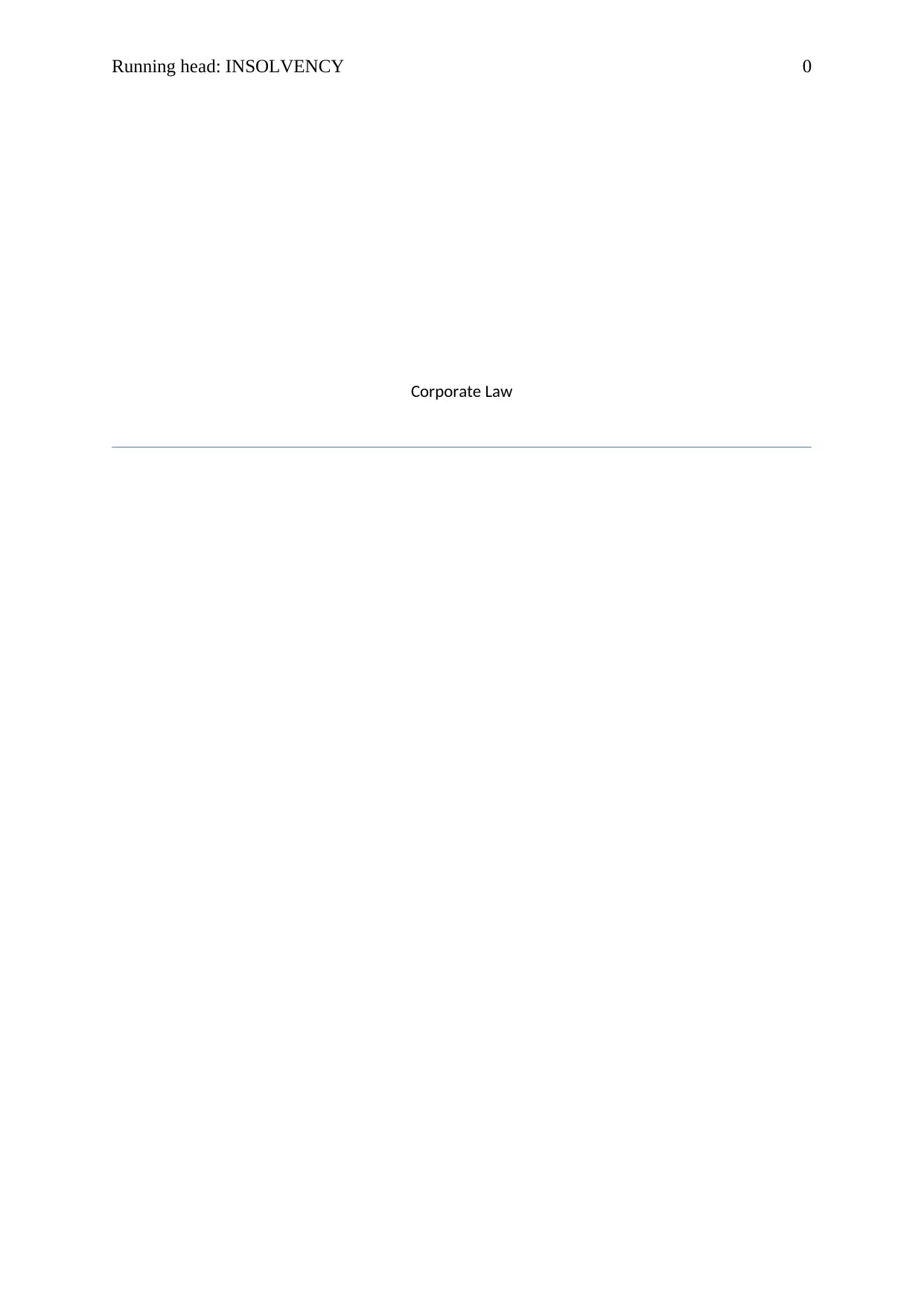
Running head: INSOLVENCY 0
Corporate Law
Corporate Law
Paraphrase This Document
Need a fresh take? Get an instant paraphrase of this document with our AI Paraphraser
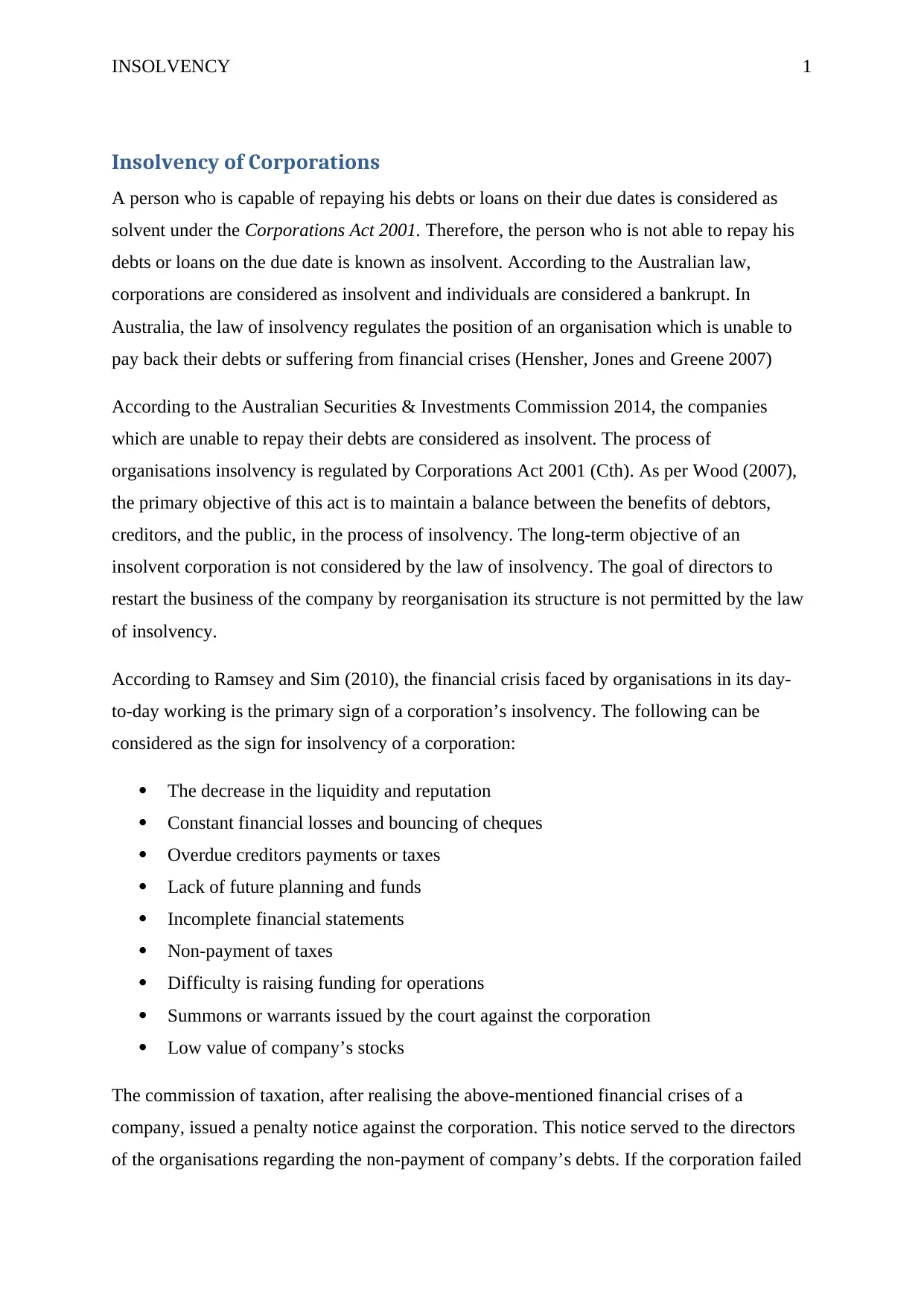
INSOLVENCY 1
Insolvency of Corporations
A person who is capable of repaying his debts or loans on their due dates is considered as
solvent under the Corporations Act 2001. Therefore, the person who is not able to repay his
debts or loans on the due date is known as insolvent. According to the Australian law,
corporations are considered as insolvent and individuals are considered a bankrupt. In
Australia, the law of insolvency regulates the position of an organisation which is unable to
pay back their debts or suffering from financial crises (Hensher, Jones and Greene 2007)
According to the Australian Securities & Investments Commission 2014, the companies
which are unable to repay their debts are considered as insolvent. The process of
organisations insolvency is regulated by Corporations Act 2001 (Cth). As per Wood (2007),
the primary objective of this act is to maintain a balance between the benefits of debtors,
creditors, and the public, in the process of insolvency. The long-term objective of an
insolvent corporation is not considered by the law of insolvency. The goal of directors to
restart the business of the company by reorganisation its structure is not permitted by the law
of insolvency.
According to Ramsey and Sim (2010), the financial crisis faced by organisations in its day-
to-day working is the primary sign of a corporation’s insolvency. The following can be
considered as the sign for insolvency of a corporation:
The decrease in the liquidity and reputation
Constant financial losses and bouncing of cheques
Overdue creditors payments or taxes
Lack of future planning and funds
Incomplete financial statements
Non-payment of taxes
Difficulty is raising funding for operations
Summons or warrants issued by the court against the corporation
Low value of company’s stocks
The commission of taxation, after realising the above-mentioned financial crises of a
company, issued a penalty notice against the corporation. This notice served to the directors
of the organisations regarding the non-payment of company’s debts. If the corporation failed
Insolvency of Corporations
A person who is capable of repaying his debts or loans on their due dates is considered as
solvent under the Corporations Act 2001. Therefore, the person who is not able to repay his
debts or loans on the due date is known as insolvent. According to the Australian law,
corporations are considered as insolvent and individuals are considered a bankrupt. In
Australia, the law of insolvency regulates the position of an organisation which is unable to
pay back their debts or suffering from financial crises (Hensher, Jones and Greene 2007)
According to the Australian Securities & Investments Commission 2014, the companies
which are unable to repay their debts are considered as insolvent. The process of
organisations insolvency is regulated by Corporations Act 2001 (Cth). As per Wood (2007),
the primary objective of this act is to maintain a balance between the benefits of debtors,
creditors, and the public, in the process of insolvency. The long-term objective of an
insolvent corporation is not considered by the law of insolvency. The goal of directors to
restart the business of the company by reorganisation its structure is not permitted by the law
of insolvency.
According to Ramsey and Sim (2010), the financial crisis faced by organisations in its day-
to-day working is the primary sign of a corporation’s insolvency. The following can be
considered as the sign for insolvency of a corporation:
The decrease in the liquidity and reputation
Constant financial losses and bouncing of cheques
Overdue creditors payments or taxes
Lack of future planning and funds
Incomplete financial statements
Non-payment of taxes
Difficulty is raising funding for operations
Summons or warrants issued by the court against the corporation
Low value of company’s stocks
The commission of taxation, after realising the above-mentioned financial crises of a
company, issued a penalty notice against the corporation. This notice served to the directors
of the organisations regarding the non-payment of company’s debts. If the corporation failed
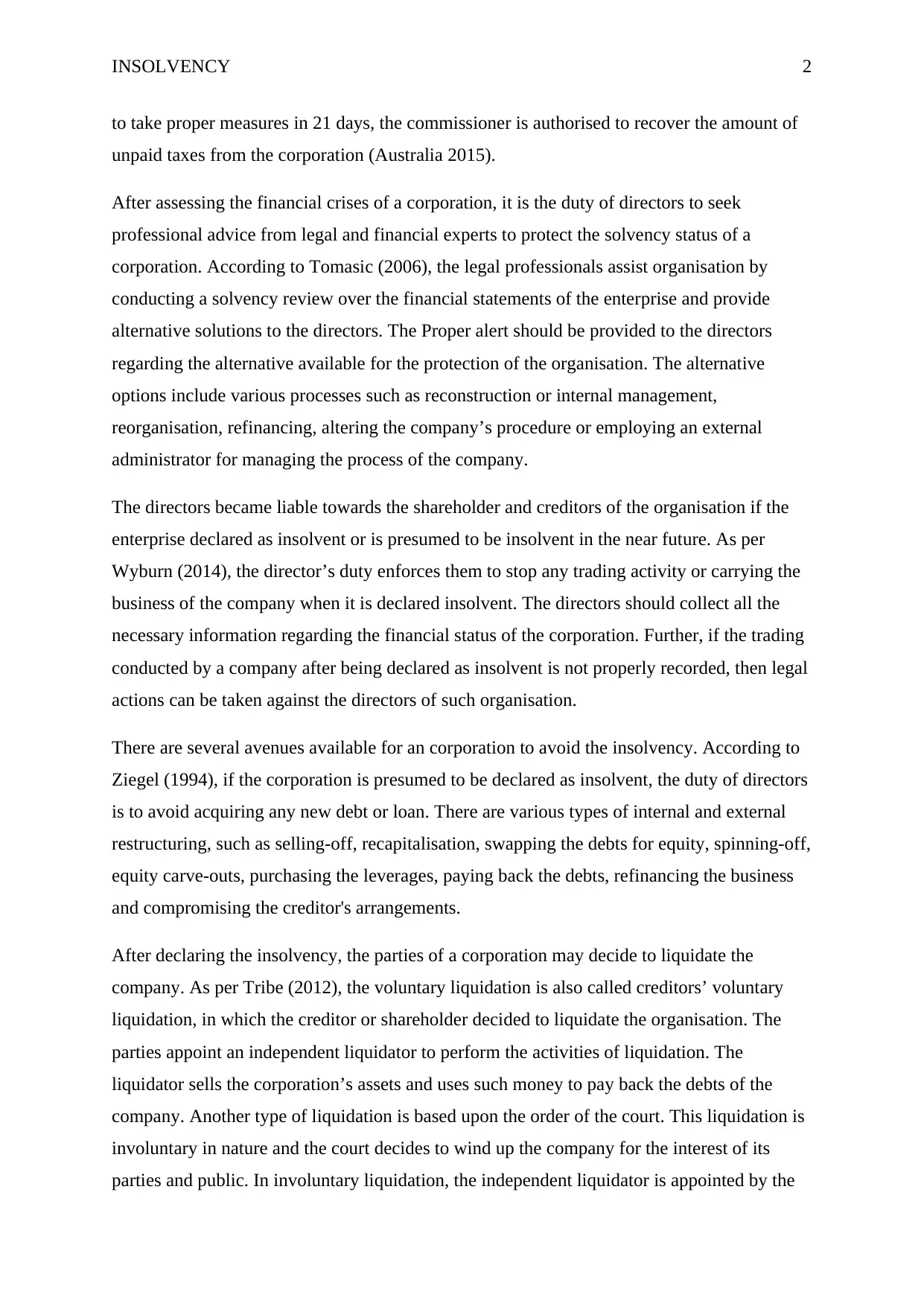
INSOLVENCY 2
to take proper measures in 21 days, the commissioner is authorised to recover the amount of
unpaid taxes from the corporation (Australia 2015).
After assessing the financial crises of a corporation, it is the duty of directors to seek
professional advice from legal and financial experts to protect the solvency status of a
corporation. According to Tomasic (2006), the legal professionals assist organisation by
conducting a solvency review over the financial statements of the enterprise and provide
alternative solutions to the directors. The Proper alert should be provided to the directors
regarding the alternative available for the protection of the organisation. The alternative
options include various processes such as reconstruction or internal management,
reorganisation, refinancing, altering the company’s procedure or employing an external
administrator for managing the process of the company.
The directors became liable towards the shareholder and creditors of the organisation if the
enterprise declared as insolvent or is presumed to be insolvent in the near future. As per
Wyburn (2014), the director’s duty enforces them to stop any trading activity or carrying the
business of the company when it is declared insolvent. The directors should collect all the
necessary information regarding the financial status of the corporation. Further, if the trading
conducted by a company after being declared as insolvent is not properly recorded, then legal
actions can be taken against the directors of such organisation.
There are several avenues available for an corporation to avoid the insolvency. According to
Ziegel (1994), if the corporation is presumed to be declared as insolvent, the duty of directors
is to avoid acquiring any new debt or loan. There are various types of internal and external
restructuring, such as selling-off, recapitalisation, swapping the debts for equity, spinning-off,
equity carve-outs, purchasing the leverages, paying back the debts, refinancing the business
and compromising the creditor's arrangements.
After declaring the insolvency, the parties of a corporation may decide to liquidate the
company. As per Tribe (2012), the voluntary liquidation is also called creditors’ voluntary
liquidation, in which the creditor or shareholder decided to liquidate the organisation. The
parties appoint an independent liquidator to perform the activities of liquidation. The
liquidator sells the corporation’s assets and uses such money to pay back the debts of the
company. Another type of liquidation is based upon the order of the court. This liquidation is
involuntary in nature and the court decides to wind up the company for the interest of its
parties and public. In involuntary liquidation, the independent liquidator is appointed by the
to take proper measures in 21 days, the commissioner is authorised to recover the amount of
unpaid taxes from the corporation (Australia 2015).
After assessing the financial crises of a corporation, it is the duty of directors to seek
professional advice from legal and financial experts to protect the solvency status of a
corporation. According to Tomasic (2006), the legal professionals assist organisation by
conducting a solvency review over the financial statements of the enterprise and provide
alternative solutions to the directors. The Proper alert should be provided to the directors
regarding the alternative available for the protection of the organisation. The alternative
options include various processes such as reconstruction or internal management,
reorganisation, refinancing, altering the company’s procedure or employing an external
administrator for managing the process of the company.
The directors became liable towards the shareholder and creditors of the organisation if the
enterprise declared as insolvent or is presumed to be insolvent in the near future. As per
Wyburn (2014), the director’s duty enforces them to stop any trading activity or carrying the
business of the company when it is declared insolvent. The directors should collect all the
necessary information regarding the financial status of the corporation. Further, if the trading
conducted by a company after being declared as insolvent is not properly recorded, then legal
actions can be taken against the directors of such organisation.
There are several avenues available for an corporation to avoid the insolvency. According to
Ziegel (1994), if the corporation is presumed to be declared as insolvent, the duty of directors
is to avoid acquiring any new debt or loan. There are various types of internal and external
restructuring, such as selling-off, recapitalisation, swapping the debts for equity, spinning-off,
equity carve-outs, purchasing the leverages, paying back the debts, refinancing the business
and compromising the creditor's arrangements.
After declaring the insolvency, the parties of a corporation may decide to liquidate the
company. As per Tribe (2012), the voluntary liquidation is also called creditors’ voluntary
liquidation, in which the creditor or shareholder decided to liquidate the organisation. The
parties appoint an independent liquidator to perform the activities of liquidation. The
liquidator sells the corporation’s assets and uses such money to pay back the debts of the
company. Another type of liquidation is based upon the order of the court. This liquidation is
involuntary in nature and the court decides to wind up the company for the interest of its
parties and public. In involuntary liquidation, the independent liquidator is appointed by the
⊘ This is a preview!⊘
Do you want full access?
Subscribe today to unlock all pages.

Trusted by 1+ million students worldwide
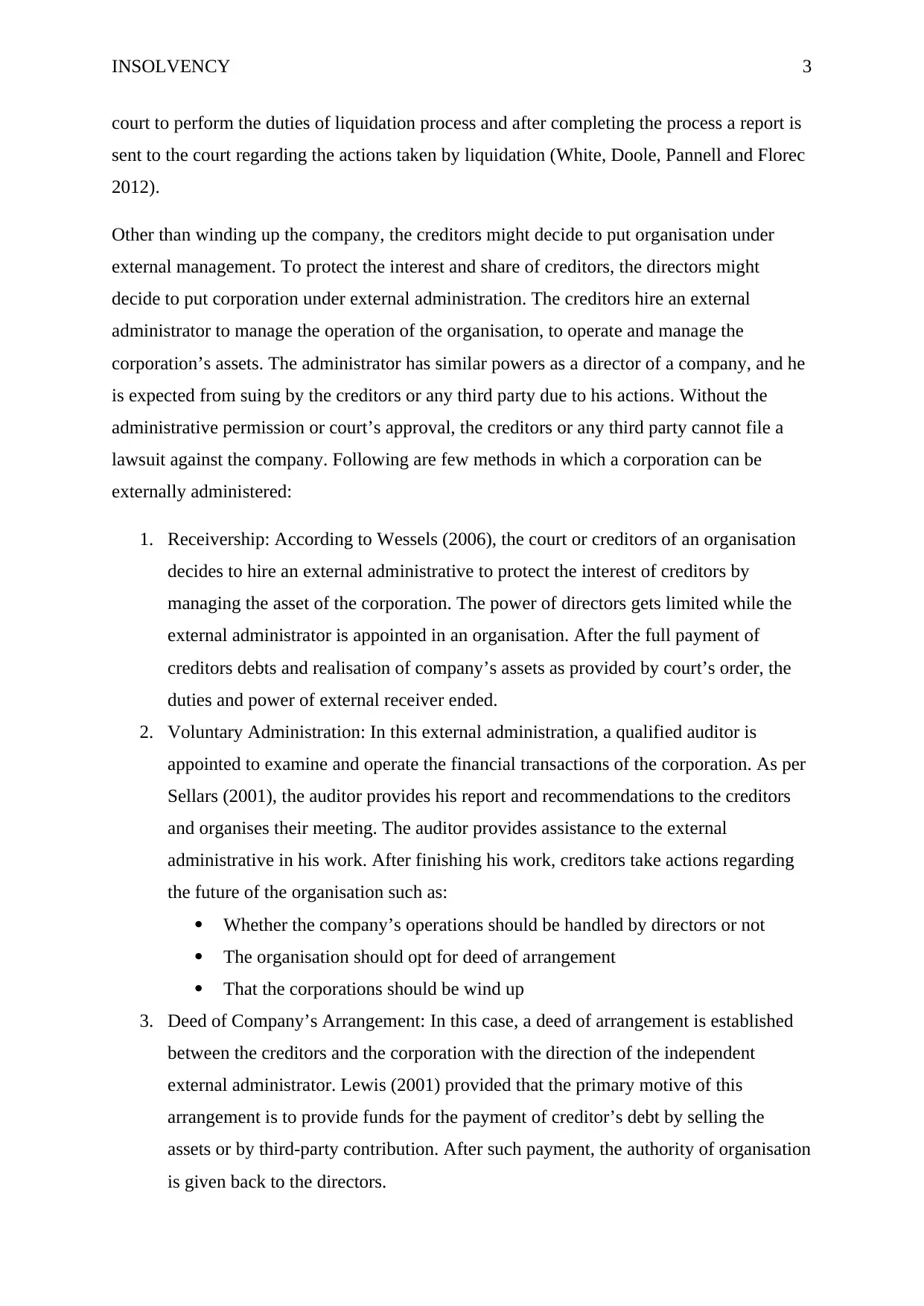
INSOLVENCY 3
court to perform the duties of liquidation process and after completing the process a report is
sent to the court regarding the actions taken by liquidation (White, Doole, Pannell and Florec
2012).
Other than winding up the company, the creditors might decide to put organisation under
external management. To protect the interest and share of creditors, the directors might
decide to put corporation under external administration. The creditors hire an external
administrator to manage the operation of the organisation, to operate and manage the
corporation’s assets. The administrator has similar powers as a director of a company, and he
is expected from suing by the creditors or any third party due to his actions. Without the
administrative permission or court’s approval, the creditors or any third party cannot file a
lawsuit against the company. Following are few methods in which a corporation can be
externally administered:
1. Receivership: According to Wessels (2006), the court or creditors of an organisation
decides to hire an external administrative to protect the interest of creditors by
managing the asset of the corporation. The power of directors gets limited while the
external administrator is appointed in an organisation. After the full payment of
creditors debts and realisation of company’s assets as provided by court’s order, the
duties and power of external receiver ended.
2. Voluntary Administration: In this external administration, a qualified auditor is
appointed to examine and operate the financial transactions of the corporation. As per
Sellars (2001), the auditor provides his report and recommendations to the creditors
and organises their meeting. The auditor provides assistance to the external
administrative in his work. After finishing his work, creditors take actions regarding
the future of the organisation such as:
Whether the company’s operations should be handled by directors or not
The organisation should opt for deed of arrangement
That the corporations should be wind up
3. Deed of Company’s Arrangement: In this case, a deed of arrangement is established
between the creditors and the corporation with the direction of the independent
external administrator. Lewis (2001) provided that the primary motive of this
arrangement is to provide funds for the payment of creditor’s debt by selling the
assets or by third-party contribution. After such payment, the authority of organisation
is given back to the directors.
court to perform the duties of liquidation process and after completing the process a report is
sent to the court regarding the actions taken by liquidation (White, Doole, Pannell and Florec
2012).
Other than winding up the company, the creditors might decide to put organisation under
external management. To protect the interest and share of creditors, the directors might
decide to put corporation under external administration. The creditors hire an external
administrator to manage the operation of the organisation, to operate and manage the
corporation’s assets. The administrator has similar powers as a director of a company, and he
is expected from suing by the creditors or any third party due to his actions. Without the
administrative permission or court’s approval, the creditors or any third party cannot file a
lawsuit against the company. Following are few methods in which a corporation can be
externally administered:
1. Receivership: According to Wessels (2006), the court or creditors of an organisation
decides to hire an external administrative to protect the interest of creditors by
managing the asset of the corporation. The power of directors gets limited while the
external administrator is appointed in an organisation. After the full payment of
creditors debts and realisation of company’s assets as provided by court’s order, the
duties and power of external receiver ended.
2. Voluntary Administration: In this external administration, a qualified auditor is
appointed to examine and operate the financial transactions of the corporation. As per
Sellars (2001), the auditor provides his report and recommendations to the creditors
and organises their meeting. The auditor provides assistance to the external
administrative in his work. After finishing his work, creditors take actions regarding
the future of the organisation such as:
Whether the company’s operations should be handled by directors or not
The organisation should opt for deed of arrangement
That the corporations should be wind up
3. Deed of Company’s Arrangement: In this case, a deed of arrangement is established
between the creditors and the corporation with the direction of the independent
external administrator. Lewis (2001) provided that the primary motive of this
arrangement is to provide funds for the payment of creditor’s debt by selling the
assets or by third-party contribution. After such payment, the authority of organisation
is given back to the directors.
Paraphrase This Document
Need a fresh take? Get an instant paraphrase of this document with our AI Paraphraser
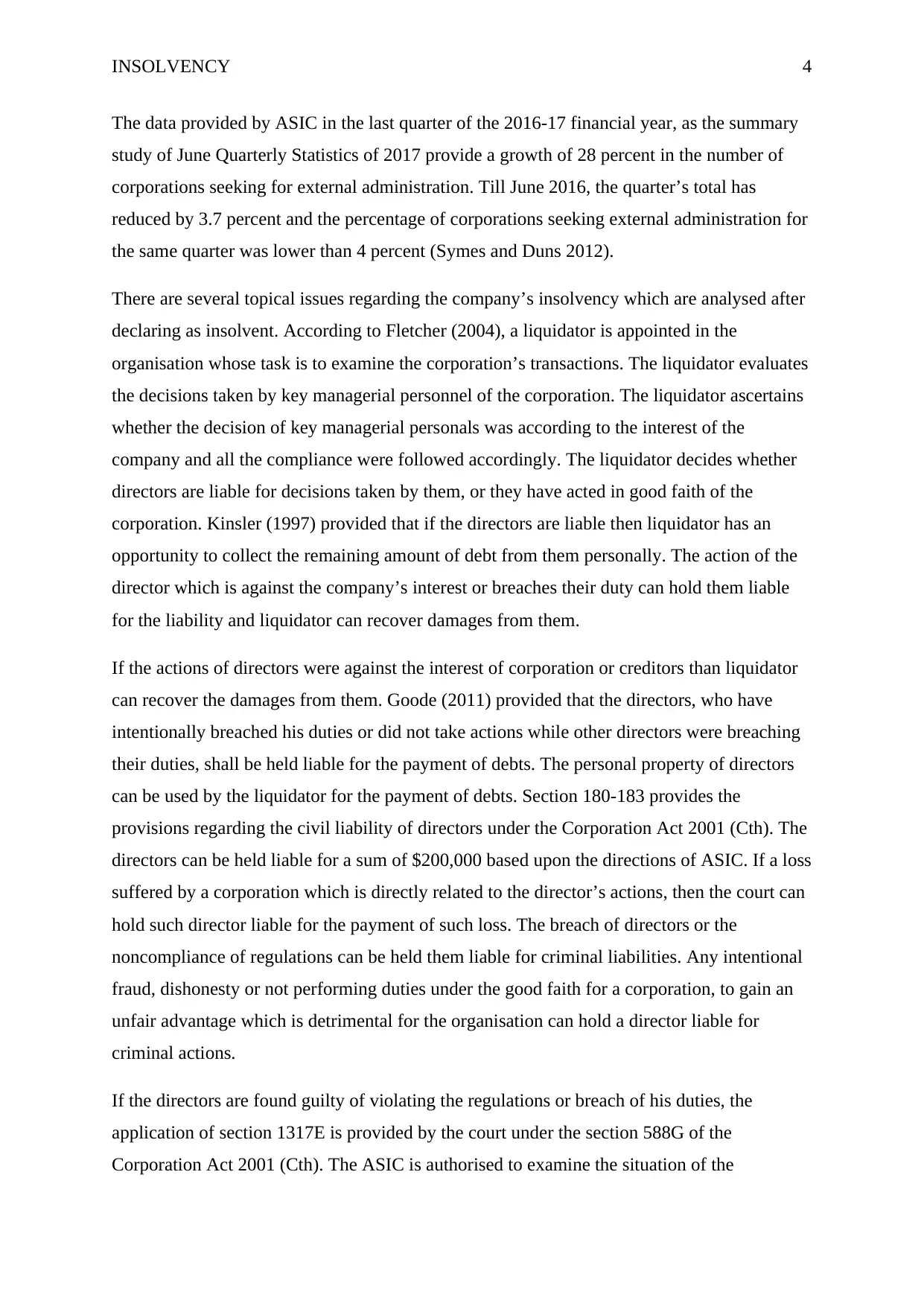
INSOLVENCY 4
The data provided by ASIC in the last quarter of the 2016-17 financial year, as the summary
study of June Quarterly Statistics of 2017 provide a growth of 28 percent in the number of
corporations seeking for external administration. Till June 2016, the quarter’s total has
reduced by 3.7 percent and the percentage of corporations seeking external administration for
the same quarter was lower than 4 percent (Symes and Duns 2012).
There are several topical issues regarding the company’s insolvency which are analysed after
declaring as insolvent. According to Fletcher (2004), a liquidator is appointed in the
organisation whose task is to examine the corporation’s transactions. The liquidator evaluates
the decisions taken by key managerial personnel of the corporation. The liquidator ascertains
whether the decision of key managerial personals was according to the interest of the
company and all the compliance were followed accordingly. The liquidator decides whether
directors are liable for decisions taken by them, or they have acted in good faith of the
corporation. Kinsler (1997) provided that if the directors are liable then liquidator has an
opportunity to collect the remaining amount of debt from them personally. The action of the
director which is against the company’s interest or breaches their duty can hold them liable
for the liability and liquidator can recover damages from them.
If the actions of directors were against the interest of corporation or creditors than liquidator
can recover the damages from them. Goode (2011) provided that the directors, who have
intentionally breached his duties or did not take actions while other directors were breaching
their duties, shall be held liable for the payment of debts. The personal property of directors
can be used by the liquidator for the payment of debts. Section 180-183 provides the
provisions regarding the civil liability of directors under the Corporation Act 2001 (Cth). The
directors can be held liable for a sum of $200,000 based upon the directions of ASIC. If a loss
suffered by a corporation which is directly related to the director’s actions, then the court can
hold such director liable for the payment of such loss. The breach of directors or the
noncompliance of regulations can be held them liable for criminal liabilities. Any intentional
fraud, dishonesty or not performing duties under the good faith for a corporation, to gain an
unfair advantage which is detrimental for the organisation can hold a director liable for
criminal actions.
If the directors are found guilty of violating the regulations or breach of his duties, the
application of section 1317E is provided by the court under the section 588G of the
Corporation Act 2001 (Cth). The ASIC is authorised to examine the situation of the
The data provided by ASIC in the last quarter of the 2016-17 financial year, as the summary
study of June Quarterly Statistics of 2017 provide a growth of 28 percent in the number of
corporations seeking for external administration. Till June 2016, the quarter’s total has
reduced by 3.7 percent and the percentage of corporations seeking external administration for
the same quarter was lower than 4 percent (Symes and Duns 2012).
There are several topical issues regarding the company’s insolvency which are analysed after
declaring as insolvent. According to Fletcher (2004), a liquidator is appointed in the
organisation whose task is to examine the corporation’s transactions. The liquidator evaluates
the decisions taken by key managerial personnel of the corporation. The liquidator ascertains
whether the decision of key managerial personals was according to the interest of the
company and all the compliance were followed accordingly. The liquidator decides whether
directors are liable for decisions taken by them, or they have acted in good faith of the
corporation. Kinsler (1997) provided that if the directors are liable then liquidator has an
opportunity to collect the remaining amount of debt from them personally. The action of the
director which is against the company’s interest or breaches their duty can hold them liable
for the liability and liquidator can recover damages from them.
If the actions of directors were against the interest of corporation or creditors than liquidator
can recover the damages from them. Goode (2011) provided that the directors, who have
intentionally breached his duties or did not take actions while other directors were breaching
their duties, shall be held liable for the payment of debts. The personal property of directors
can be used by the liquidator for the payment of debts. Section 180-183 provides the
provisions regarding the civil liability of directors under the Corporation Act 2001 (Cth). The
directors can be held liable for a sum of $200,000 based upon the directions of ASIC. If a loss
suffered by a corporation which is directly related to the director’s actions, then the court can
hold such director liable for the payment of such loss. The breach of directors or the
noncompliance of regulations can be held them liable for criminal liabilities. Any intentional
fraud, dishonesty or not performing duties under the good faith for a corporation, to gain an
unfair advantage which is detrimental for the organisation can hold a director liable for
criminal actions.
If the directors are found guilty of violating the regulations or breach of his duties, the
application of section 1317E is provided by the court under the section 588G of the
Corporation Act 2001 (Cth). The ASIC is authorised to examine the situation of the
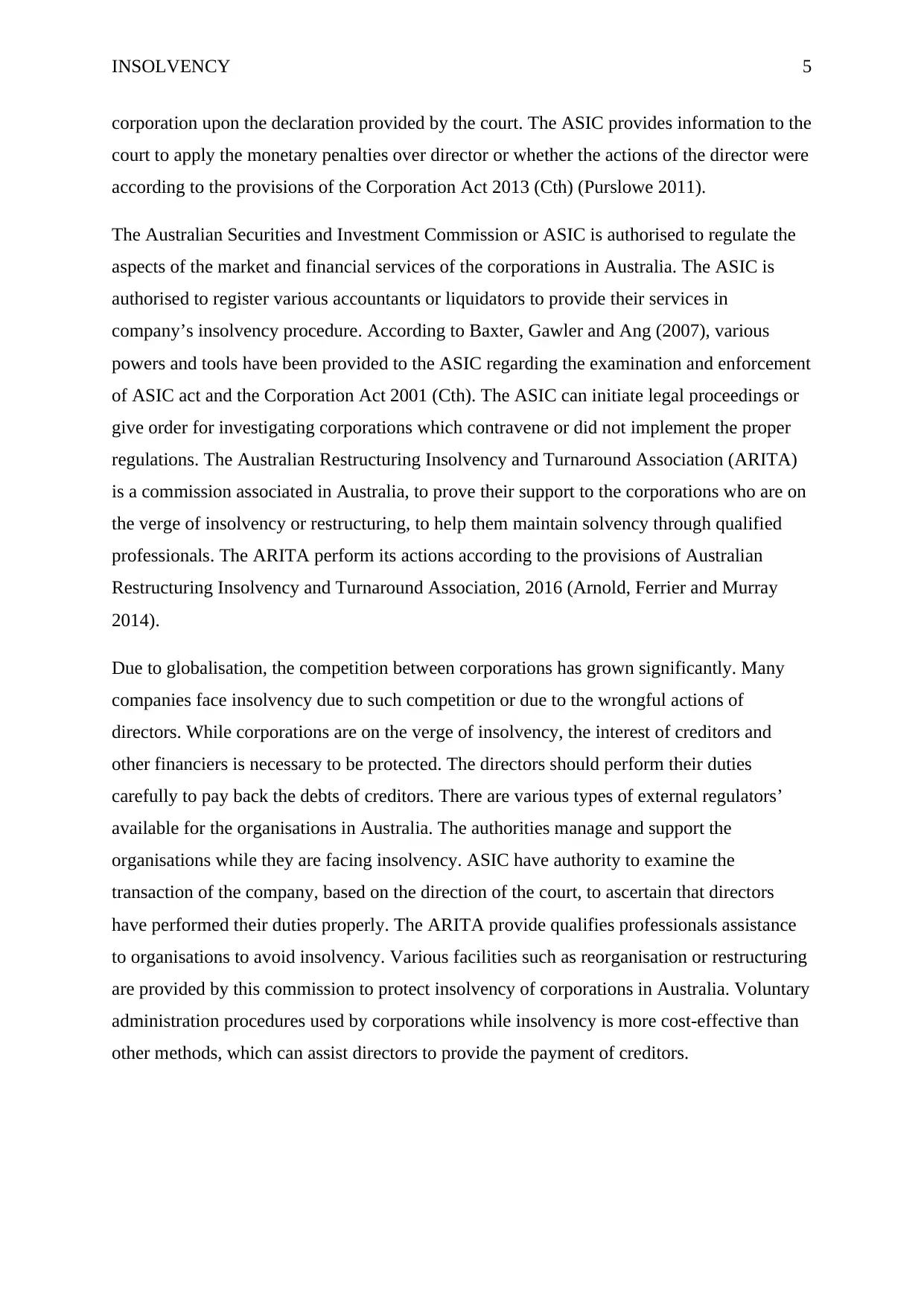
INSOLVENCY 5
corporation upon the declaration provided by the court. The ASIC provides information to the
court to apply the monetary penalties over director or whether the actions of the director were
according to the provisions of the Corporation Act 2013 (Cth) (Purslowe 2011).
The Australian Securities and Investment Commission or ASIC is authorised to regulate the
aspects of the market and financial services of the corporations in Australia. The ASIC is
authorised to register various accountants or liquidators to provide their services in
company’s insolvency procedure. According to Baxter, Gawler and Ang (2007), various
powers and tools have been provided to the ASIC regarding the examination and enforcement
of ASIC act and the Corporation Act 2001 (Cth). The ASIC can initiate legal proceedings or
give order for investigating corporations which contravene or did not implement the proper
regulations. The Australian Restructuring Insolvency and Turnaround Association (ARITA)
is a commission associated in Australia, to prove their support to the corporations who are on
the verge of insolvency or restructuring, to help them maintain solvency through qualified
professionals. The ARITA perform its actions according to the provisions of Australian
Restructuring Insolvency and Turnaround Association, 2016 (Arnold, Ferrier and Murray
2014).
Due to globalisation, the competition between corporations has grown significantly. Many
companies face insolvency due to such competition or due to the wrongful actions of
directors. While corporations are on the verge of insolvency, the interest of creditors and
other financiers is necessary to be protected. The directors should perform their duties
carefully to pay back the debts of creditors. There are various types of external regulators’
available for the organisations in Australia. The authorities manage and support the
organisations while they are facing insolvency. ASIC have authority to examine the
transaction of the company, based on the direction of the court, to ascertain that directors
have performed their duties properly. The ARITA provide qualifies professionals assistance
to organisations to avoid insolvency. Various facilities such as reorganisation or restructuring
are provided by this commission to protect insolvency of corporations in Australia. Voluntary
administration procedures used by corporations while insolvency is more cost-effective than
other methods, which can assist directors to provide the payment of creditors.
corporation upon the declaration provided by the court. The ASIC provides information to the
court to apply the monetary penalties over director or whether the actions of the director were
according to the provisions of the Corporation Act 2013 (Cth) (Purslowe 2011).
The Australian Securities and Investment Commission or ASIC is authorised to regulate the
aspects of the market and financial services of the corporations in Australia. The ASIC is
authorised to register various accountants or liquidators to provide their services in
company’s insolvency procedure. According to Baxter, Gawler and Ang (2007), various
powers and tools have been provided to the ASIC regarding the examination and enforcement
of ASIC act and the Corporation Act 2001 (Cth). The ASIC can initiate legal proceedings or
give order for investigating corporations which contravene or did not implement the proper
regulations. The Australian Restructuring Insolvency and Turnaround Association (ARITA)
is a commission associated in Australia, to prove their support to the corporations who are on
the verge of insolvency or restructuring, to help them maintain solvency through qualified
professionals. The ARITA perform its actions according to the provisions of Australian
Restructuring Insolvency and Turnaround Association, 2016 (Arnold, Ferrier and Murray
2014).
Due to globalisation, the competition between corporations has grown significantly. Many
companies face insolvency due to such competition or due to the wrongful actions of
directors. While corporations are on the verge of insolvency, the interest of creditors and
other financiers is necessary to be protected. The directors should perform their duties
carefully to pay back the debts of creditors. There are various types of external regulators’
available for the organisations in Australia. The authorities manage and support the
organisations while they are facing insolvency. ASIC have authority to examine the
transaction of the company, based on the direction of the court, to ascertain that directors
have performed their duties properly. The ARITA provide qualifies professionals assistance
to organisations to avoid insolvency. Various facilities such as reorganisation or restructuring
are provided by this commission to protect insolvency of corporations in Australia. Voluntary
administration procedures used by corporations while insolvency is more cost-effective than
other methods, which can assist directors to provide the payment of creditors.
⊘ This is a preview!⊘
Do you want full access?
Subscribe today to unlock all pages.

Trusted by 1+ million students worldwide
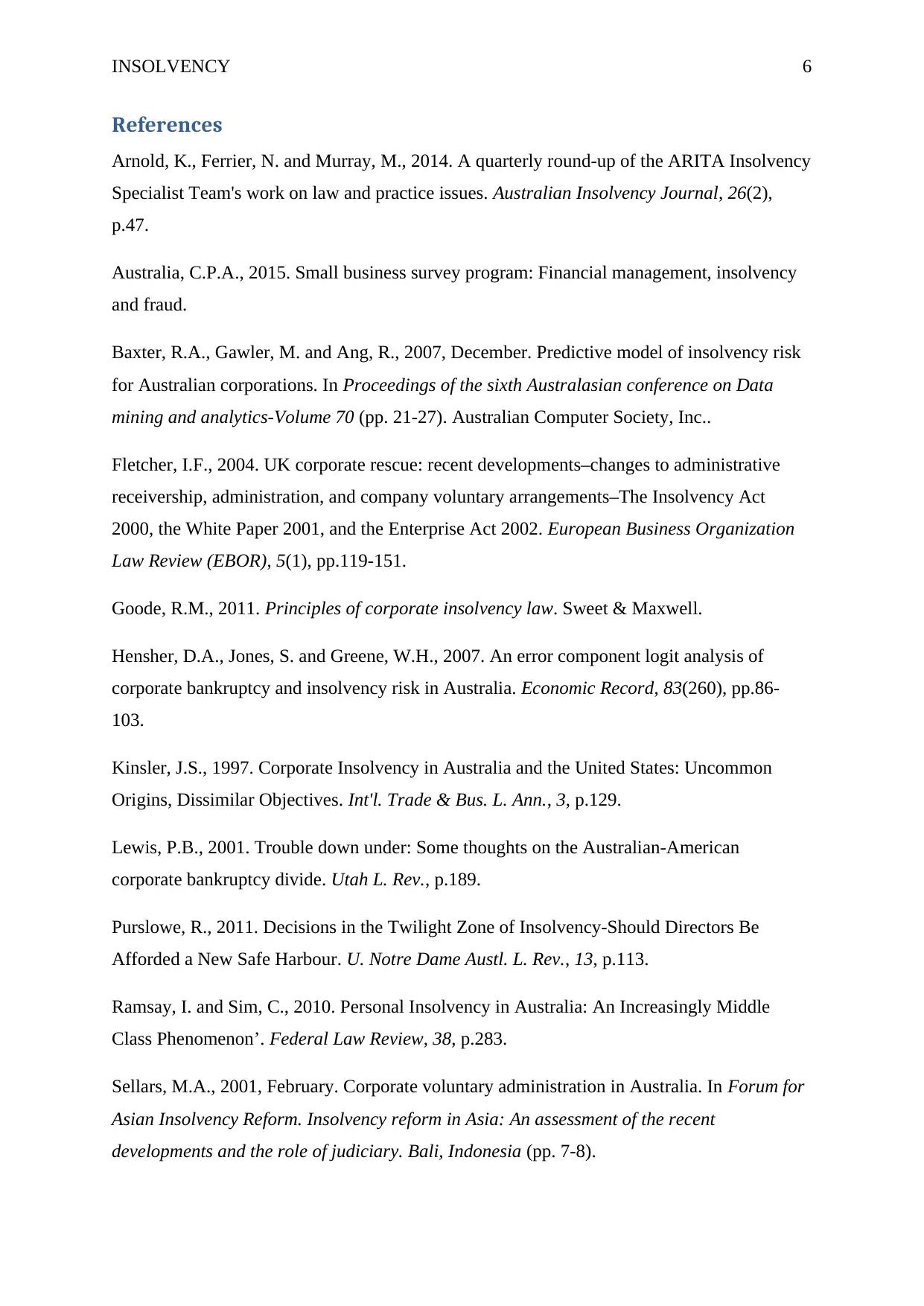
INSOLVENCY 6
References
Arnold, K., Ferrier, N. and Murray, M., 2014. A quarterly round-up of the ARITA Insolvency
Specialist Team's work on law and practice issues. Australian Insolvency Journal, 26(2),
p.47.
Australia, C.P.A., 2015. Small business survey program: Financial management, insolvency
and fraud.
Baxter, R.A., Gawler, M. and Ang, R., 2007, December. Predictive model of insolvency risk
for Australian corporations. In Proceedings of the sixth Australasian conference on Data
mining and analytics-Volume 70 (pp. 21-27). Australian Computer Society, Inc..
Fletcher, I.F., 2004. UK corporate rescue: recent developments–changes to administrative
receivership, administration, and company voluntary arrangements–The Insolvency Act
2000, the White Paper 2001, and the Enterprise Act 2002. European Business Organization
Law Review (EBOR), 5(1), pp.119-151.
Goode, R.M., 2011. Principles of corporate insolvency law. Sweet & Maxwell.
Hensher, D.A., Jones, S. and Greene, W.H., 2007. An error component logit analysis of
corporate bankruptcy and insolvency risk in Australia. Economic Record, 83(260), pp.86-
103.
Kinsler, J.S., 1997. Corporate Insolvency in Australia and the United States: Uncommon
Origins, Dissimilar Objectives. Int'l. Trade & Bus. L. Ann., 3, p.129.
Lewis, P.B., 2001. Trouble down under: Some thoughts on the Australian-American
corporate bankruptcy divide. Utah L. Rev., p.189.
Purslowe, R., 2011. Decisions in the Twilight Zone of Insolvency-Should Directors Be
Afforded a New Safe Harbour. U. Notre Dame Austl. L. Rev., 13, p.113.
Ramsay, I. and Sim, C., 2010. Personal Insolvency in Australia: An Increasingly Middle
Class Phenomenon’. Federal Law Review, 38, p.283.
Sellars, M.A., 2001, February. Corporate voluntary administration in Australia. In Forum for
Asian Insolvency Reform. Insolvency reform in Asia: An assessment of the recent
developments and the role of judiciary. Bali, Indonesia (pp. 7-8).
References
Arnold, K., Ferrier, N. and Murray, M., 2014. A quarterly round-up of the ARITA Insolvency
Specialist Team's work on law and practice issues. Australian Insolvency Journal, 26(2),
p.47.
Australia, C.P.A., 2015. Small business survey program: Financial management, insolvency
and fraud.
Baxter, R.A., Gawler, M. and Ang, R., 2007, December. Predictive model of insolvency risk
for Australian corporations. In Proceedings of the sixth Australasian conference on Data
mining and analytics-Volume 70 (pp. 21-27). Australian Computer Society, Inc..
Fletcher, I.F., 2004. UK corporate rescue: recent developments–changes to administrative
receivership, administration, and company voluntary arrangements–The Insolvency Act
2000, the White Paper 2001, and the Enterprise Act 2002. European Business Organization
Law Review (EBOR), 5(1), pp.119-151.
Goode, R.M., 2011. Principles of corporate insolvency law. Sweet & Maxwell.
Hensher, D.A., Jones, S. and Greene, W.H., 2007. An error component logit analysis of
corporate bankruptcy and insolvency risk in Australia. Economic Record, 83(260), pp.86-
103.
Kinsler, J.S., 1997. Corporate Insolvency in Australia and the United States: Uncommon
Origins, Dissimilar Objectives. Int'l. Trade & Bus. L. Ann., 3, p.129.
Lewis, P.B., 2001. Trouble down under: Some thoughts on the Australian-American
corporate bankruptcy divide. Utah L. Rev., p.189.
Purslowe, R., 2011. Decisions in the Twilight Zone of Insolvency-Should Directors Be
Afforded a New Safe Harbour. U. Notre Dame Austl. L. Rev., 13, p.113.
Ramsay, I. and Sim, C., 2010. Personal Insolvency in Australia: An Increasingly Middle
Class Phenomenon’. Federal Law Review, 38, p.283.
Sellars, M.A., 2001, February. Corporate voluntary administration in Australia. In Forum for
Asian Insolvency Reform. Insolvency reform in Asia: An assessment of the recent
developments and the role of judiciary. Bali, Indonesia (pp. 7-8).
Paraphrase This Document
Need a fresh take? Get an instant paraphrase of this document with our AI Paraphraser
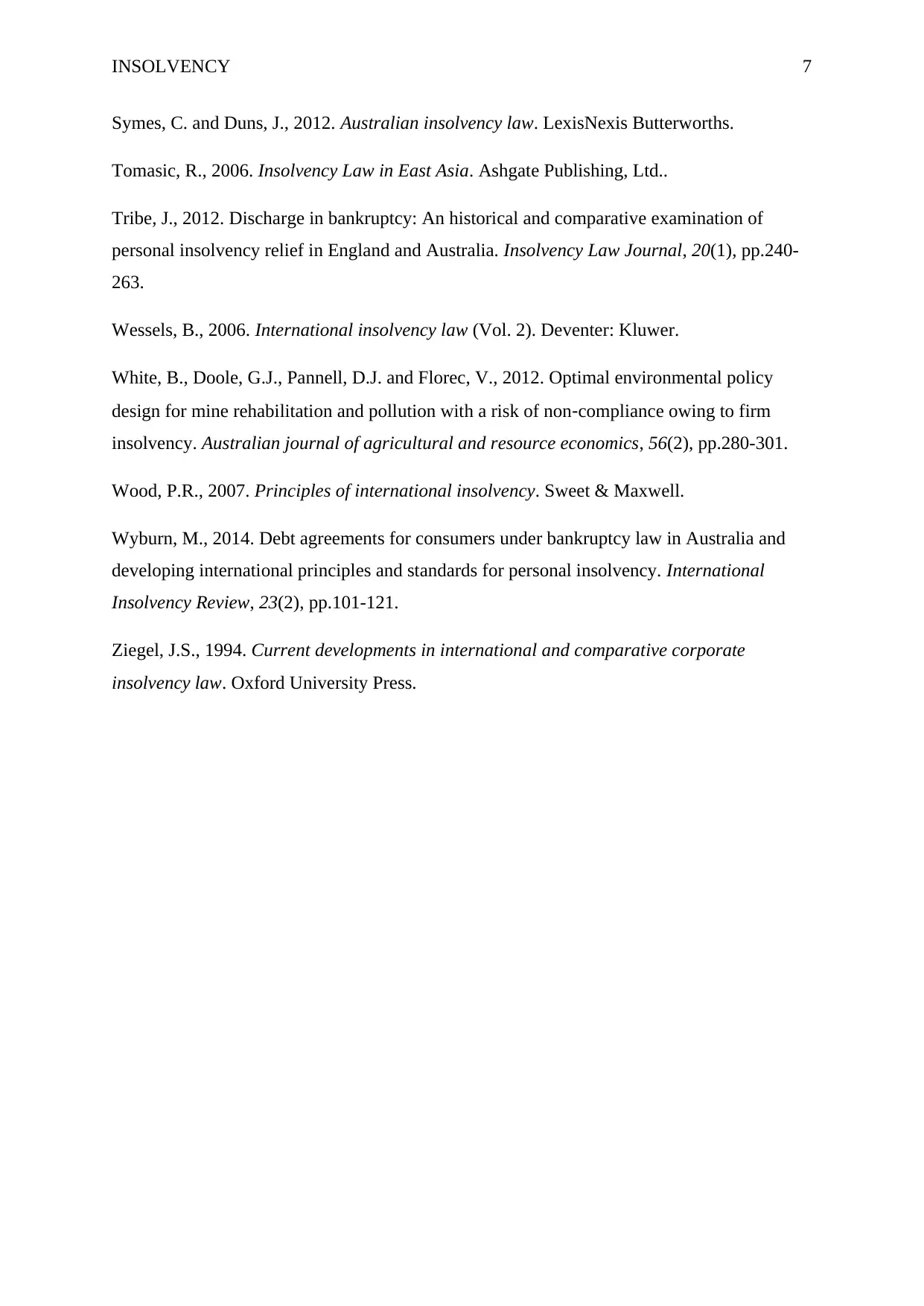
INSOLVENCY 7
Symes, C. and Duns, J., 2012. Australian insolvency law. LexisNexis Butterworths.
Tomasic, R., 2006. Insolvency Law in East Asia. Ashgate Publishing, Ltd..
Tribe, J., 2012. Discharge in bankruptcy: An historical and comparative examination of
personal insolvency relief in England and Australia. Insolvency Law Journal, 20(1), pp.240-
263.
Wessels, B., 2006. International insolvency law (Vol. 2). Deventer: Kluwer.
White, B., Doole, G.J., Pannell, D.J. and Florec, V., 2012. Optimal environmental policy
design for mine rehabilitation and pollution with a risk of non‐compliance owing to firm
insolvency. Australian journal of agricultural and resource economics, 56(2), pp.280-301.
Wood, P.R., 2007. Principles of international insolvency. Sweet & Maxwell.
Wyburn, M., 2014. Debt agreements for consumers under bankruptcy law in Australia and
developing international principles and standards for personal insolvency. International
Insolvency Review, 23(2), pp.101-121.
Ziegel, J.S., 1994. Current developments in international and comparative corporate
insolvency law. Oxford University Press.
Symes, C. and Duns, J., 2012. Australian insolvency law. LexisNexis Butterworths.
Tomasic, R., 2006. Insolvency Law in East Asia. Ashgate Publishing, Ltd..
Tribe, J., 2012. Discharge in bankruptcy: An historical and comparative examination of
personal insolvency relief in England and Australia. Insolvency Law Journal, 20(1), pp.240-
263.
Wessels, B., 2006. International insolvency law (Vol. 2). Deventer: Kluwer.
White, B., Doole, G.J., Pannell, D.J. and Florec, V., 2012. Optimal environmental policy
design for mine rehabilitation and pollution with a risk of non‐compliance owing to firm
insolvency. Australian journal of agricultural and resource economics, 56(2), pp.280-301.
Wood, P.R., 2007. Principles of international insolvency. Sweet & Maxwell.
Wyburn, M., 2014. Debt agreements for consumers under bankruptcy law in Australia and
developing international principles and standards for personal insolvency. International
Insolvency Review, 23(2), pp.101-121.
Ziegel, J.S., 1994. Current developments in international and comparative corporate
insolvency law. Oxford University Press.
1 out of 8
Related Documents
Your All-in-One AI-Powered Toolkit for Academic Success.
+13062052269
info@desklib.com
Available 24*7 on WhatsApp / Email
![[object Object]](/_next/static/media/star-bottom.7253800d.svg)
Unlock your academic potential
Copyright © 2020–2025 A2Z Services. All Rights Reserved. Developed and managed by ZUCOL.





